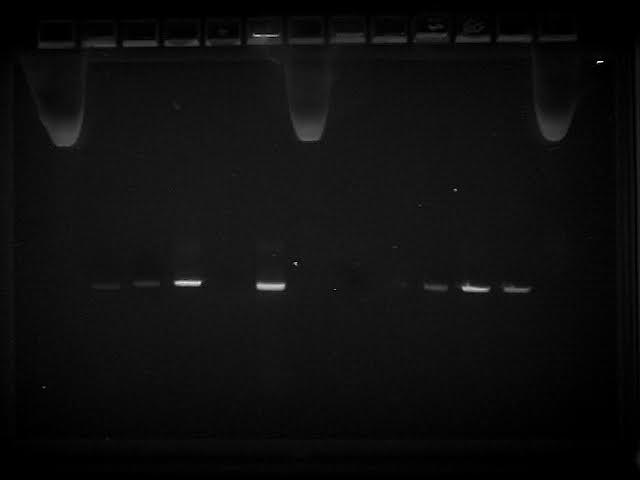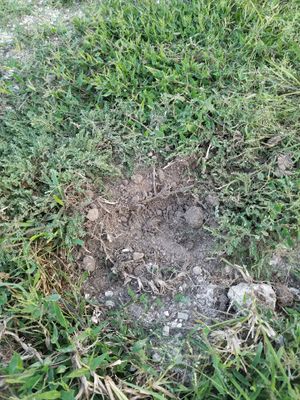B. Cereus Cudmore-Lewis: Difference between revisions
| Line 62: | Line 62: | ||
==Cell Structure, Metabolism and Life Cycle== | ==Cell Structure, Metabolism and Life Cycle== | ||
Interesting features of cell structure; how it gains energy; what important molecules it produces. | Interesting features of cell structure; how it gains energy; what important molecules it produces. | ||
A standard Gram stain was performed on the sample to observe cellular morphology.<br> | |||
Gram reaction: positive<br> | |||
Cellular morphology: very smaller, clustered rods<br><br> | |||
'''Other stain results:'''<br> | |||
Capsule stain: negative<br> | |||
Endospore stain: negative | |||
==Physiology and Pathogenesis== | ==Physiology and Pathogenesis== | ||
Revision as of 03:51, 8 December 2016
Classification
Domain: Bacteria
Phylum: Firmicutes
Class: Bacilli
Order: Bacillales
Family: Bacillaceae
Species
|
NCBI: Taxonomy |
Bacillus cereus
Habitat Information
Location:
Lat:30.002092
Long:-97.883009
Soil: Castephen Clay Loam/ 3-5% slopes, eroded
Description: New housing development, empty lot
Precipitation:Not within 48 hours
Temperature:70, few clouds
Depth: 1.25 inches
Visibility: 10 miles
Humidity: 59%
Wind: S 10 mph
Sea Level: 1011.8
Date & Time: September 8, 2016, 18:53
Description and Significance
Describe the appearance (colonial and cellular), possible antimicrobial activity etc. of the organism, and why the organism might be significant.
Description:
Color- Yellow
Form: Circular
Margin: Entire
Consistency: Semi-mucoid
Texture: Smooth
Elevation: Raised
Antibacterial Activity: None
Antibiotic Resistance: Nafcillin
Genome Structure
Describe the size and content of the genome. How many chromosomes? Circular or linear? Other interesting features? What is known about its sequence?
S Ribosomal sequences obtained from PCR:
GACNGANCAACGCCGCGTGAGTGATGAAGGCTNTCCCNTCNNAAAACTCTGTTGTTAGGGAAGAACAAGTGCTAGTTGAATAAGCTGGCACCTTGACGGTACCTAACCAGAAAGCCACGGCTAACTACGTGCCAGCAGCCGCGGTAATACGTANGTGGCAAGCGTTATCCGGAATTATTGGGCGTAAAGCGCGCGCAGGTGGNTTCTTAAGTCTGATGTGAAAGCCCACGGCTCANCCGTGGAGGGTCATTGGAAACTGGGAGACTTGAGTGCAGAAGAGGAAAGTGGAATTCCATGTGTAGCGGTGAAATGCGTAGAGATATGGAGGAACACCAGTGGCGAAGGCGACTTTCTGGTCTGTAACTGACACTGAGGCGCGAAAGCGTGGGGAGCAAACAGGATTAGATACCCTGGTAGTCCACGCCGTAAACGATGAGTGCTAAGTGTTAGAGGGTTTCCGCCCTTTAGTGCTGAAGTTAACGCATTAAGCACTCCGCCTGGGGAGTACGGCCGCAAGGCTGAAACTCAAAGGAATTGACGGGGGCCCGCACAAGCGGTGGAGCATGTGGTTTAATTCGAAGCAACGCGAANAACCTTACCAGNTCTTGACATCCTCTGACAACCCTANAGATAGGGCTTCTCCTTCGGGAGCAGAGTGACAGGTGGGTGCATGGTTGTCGTCAGCTCGTGNCCNTNNNATGTCNTANCTGTTTCCNGNANNTNNNNNNNNNNNNNNNNNNNNNNNNNNNNNNNNNNNNNNNNNN

Gel Electrophoresis results from Microbiology class. Well 4 is B. cereus sample collected by Lewis and Cudmore.
Cell Structure, Metabolism and Life Cycle
Interesting features of cell structure; how it gains energy; what important molecules it produces.
A standard Gram stain was performed on the sample to observe cellular morphology.
Gram reaction: positive
Cellular morphology: very smaller, clustered rods
Other stain results:
Capsule stain: negative
Endospore stain: negative
Physiology and Pathogenesis
The pathogenicity of B. cereus, whether intestinal or non-intestinal, is intimately associated with the production of tissue-destructive exoenzymes.Among these secreted toxins are four hemolysins, three distinct phospholipases, an emesis-inducing toxin, and proteases. (1)
B. cereus has been known to cause food-borne illness as well as skin infections in humans. In some animals, B. cereus can be used as a probiotic.
B. cereus was found to be the most common contaminant in pharmaceutical manufacturing. (2)
References
1. Bottone, Edward J. “Bacillus Cereus, a Volatile Human Pathogen.” Clinical Microbiology Reviews 23.2 (2010): 382–398. PMC. Web. 7 Dec. 2016.
2. Sandle, Tim (28 November 2014). "The Risk of Bacillus cereus to Pharmaceutical Manufacturing". American Pharmaceutical Review (Paper). 17 (6): 56.
Author
Page authored by Carley Cudmore and Jennifer Lewis, students of Prof. Kristine Hollingsworth at Austin Community College.

